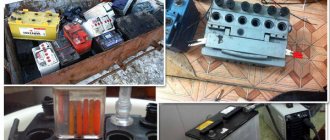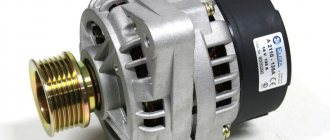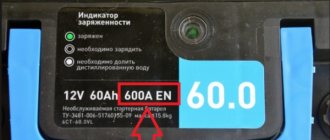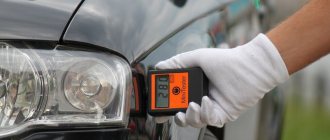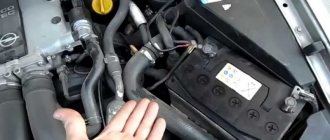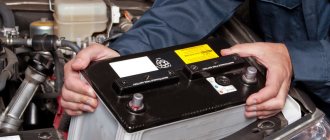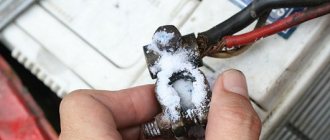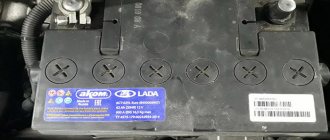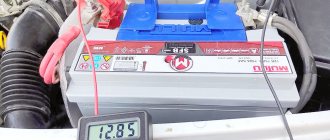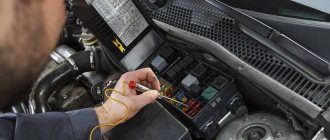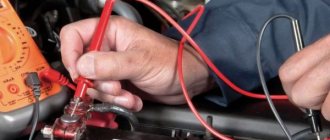Many drivers have found themselves in a situation where everything was fine with the car in the evening, but in the morning for some reason it did not want to start. At the same time, the battery has not yet had time to “outlive its usefulness”, that is, everything is normal with it. One of the obvious reasons is the leakage current of the car battery. The phenomenon is normal and occurs on all machines, but must comply with certain standards. If the permissible limit is exceeded, the battery will begin to lose charge even when the car is not in use. As a result, difficulties will arise when starting the engine. What is the normal leakage current for a car battery, what causes it, how the test is performed, and what to do when deviations are detected - in the article.
Leakage current may cause rapid battery discharge.
What is leakage current and how does it happen?
Let's start with a specific example. Let's say we have a battery, a light bulb and a switch. Let's assemble a simple electrical circuit from all this, so that the light bulb can be controlled using a switch. Now consider two situations - in one the light bulb will be on, and in the other it will be off.
When the light bulb is turned on, an electric current naturally flows through the circuit. Question: can this current be called leakage current? Don't rush to answer. In fact, not everything is as simple as it seems. On the one hand, there is no leakage in this situation, since the current flowing through the circuit seems to be used to perform useful work. What kind of leakage is there if the current flows profitably?
Nevertheless, there is always a current leak in this case. That is, not all the energy that is taken from the battery is spent on useful work. And this is exactly what is not spent on useful work - this is, in essence, a leak. Leakage current. Where is she? Where does the current flow without use? And current leakage in this case occurs in the wires that connect the circuit elements. Since they have some resistance, part of the current flowing through them is wasted on heating them. This is, in principle, also work. But for us it is not useful (and even harmful).
The second situation is when the light bulb is turned off using the switch. Is it possible to detect leakage current in this situation? Of course not, if the system is working properly. What if the switch is faulty? For example, salt water got into it, and even in the off position it does not completely break the circuit. The light bulb may glow with a weak glow or not glow at all, but the battery will waste energy. In such a situation, we are dealing with a real leakage current. Under the conditions described, it flows in our circuit.
Now let's complicate things a little. Instead of a light bulb, let's connect some electronics to our circuit that operate in two modes - main and standby. In a car, such a device is, for example, a radio. When we turn off a consumer of this kind, it goes into the so-called sleep or standby mode. In this mode, the device consumes energy from the battery, that is, current flows in our circuit.
Now the question is: is this leakage current? On the one hand, it seems, yes. Indeed, in the case of a radio tape recorder, we are not listening to music at this moment, which means that work useful to us is not being performed. On the other hand, the current, which many call leakage, is spent by the radio on not so useless work - storing settings, clock movements, and so on.
So what then is leakage current in a car? And this is the current that flows in the circuit, but is not spent on doing useful work.
In the case of household electrical networks, the boundary in this matter is clearer. In properly organized systems, there is even a special automatic circuit breaker that, in the event of a current leak, completely cuts off the power supply.
However, when considering the issue of current leakage in machines, the line is not so clear. In the case of cars, leakage current is generally considered to be any current that is drained from the battery while parked. And this despite the fact that not all energy is wasted in this mode.
Reasons for battery drain
During a long period of inactivity, the charge in the unit must be maintained. The battery discharges quickly when a large number of different devices are connected to the network. Often in such situations, the current loss in the machine is much higher than the permissible values.
Among the standard reasons for such problems are:
- Low quality old wiring.
- Incorrect electrical connection.
- Dirty and oxidized contacts.
How to check current leakage in a car
Checking the total current leakage along the 12 V line of the car is very simple: you need to turn on the multimeter in ammeter mode in the gap between the battery and the rest of the car's network. In this case, the engine must be turned off and no manipulations with the ignition must be performed. Huge starting currents of the starter will definitely lead to damage to the multimeter and burns.
It is important! Before starting to work with a multimeter, it is recommended that you read the training article on working with the device.
Let's look at the process in more detail:
- Turn off the ignition and all additional consumers.
- We get to the battery and, using a suitable wrench, unscrew its negative terminal.
- Set the multimeter to DC ammeter mode. We set the maximum measurement limit. On most typical meters this is either 10 or 20 A. We connect the probes to the appropriately marked sockets. Please note that in ammeter mode the resistance of the “tester” is zero, so if you touch the two battery terminals with the probes out of habit, you will get a short circuit.
To measure leakage current, you must turn the multimeter into DC measurement mode
It is important! Do not use a jack marked “FUSED”. This multimeter input is protected by a fuse, usually 200 or 500 mA. The leakage current is unknown to us in advance and can be much greater, which will lead to failure of the fuse. The inscription “UNFUSED” indicates that there is no fuse in this line.
- Now we connect the probes into the gap: black to the minus on the battery, red to ground. For some older meters, polarity may be important, but on a digital meter it doesn't matter.
- We look at the instrument readings. In the picture above we can see a result of 70 mA, which is quite normal. But here it’s worth thinking about, 230 mA is a lot.
If all electronic equipment is truly turned off, then a current value of 230 mA indicates serious problems
An important subtlety: after closing the on-board circuit with a multimeter, in the first couple of minutes the leakage current can be quite large. This is explained by the fact that de-energized devices have just received power and have not yet entered energy saving mode.
Hold the probes firmly on the contacts and wait up to five minutes (you can use alligator clip probes to ensure a reliable connection for such a long time). Most likely, the current will gradually drop. If high values remain, there is definitely a problem with the electrical equipment.
Normal leakage current values vary for different vehicles. Approximately this is 20-70 mA, but for older cars they can be significantly higher, as well as for domestically produced cars. Modern foreign cars can generally consume only a few milliamps when parked. It's best to use the Internet and find out what values are acceptable for your model.
What should you keep in mind?
When carrying out preventive maintenance on the battery, we recommend checking the leakage current of the car battery. On a modern car, the norm is a value of 15─75 mA with the on-board network consumers turned off.
If the leakage current value significantly exceeds the norm, then at a minimum you should consult an automobile electrician. If you have a tester and the skills to handle it, then you can find the problematic device or faulty wiring yourself. We also recommend reading about how to check battery capacity. In any case, leakage current exceeding the norm cannot be ignored. After all, this can end not just with a dead battery, but also with a fire in worn-out wiring. Be careful and good luck on the roads! If you have additions or feedback to the article, write them in the comments below.
What leakage current is normal?
In any car there is a minimum leakage current of the order of 50-80 mA. This indicator depends on many factors. In particular: the condition of the wiring, the age of the battery and the cleanliness of its terminals, as well as air temperature. Self-discharge of the battery in an open circuit is allowed no more than 1% per day, but given that it is constantly connected to the on-board network, this figure can reach up to 4 percent. Thus, the permissible leakage will be equal to the capacity multiplied by a factor of 0.4.
Since, in addition to the permissible leakage of current from the battery in a car, even at rest the following consumers can consume current: alarm and immobilizer (20-25 mA), audio system (3 mA), central locking unit and ECU controller (5 mA each), then The quiescent current will be significantly higher. In total, the provoked leakage current rate is considered to be 50-70 mA, and the maximum permissible value is 80-90 mA.
Increased current can occur due to: rotten old wiring (in most cases), a short circuit in the circuit through oxides, damaged wire insulation and an incorrectly connected alarm or radio. Although a small current consumption by the alarm is acceptable, since it is an active device and requires power to the radio module, volume/shock sensors and LED.
Our online calculator will help you calculate the leakage current depending on the self-discharge of the battery (for a new battery the rate of loss is 0.5–1.0% and for a used battery 1–1.7%) and the number of consumers who consume energy even in standby mode normal (natural) leakage of quiescent current from a car battery.
Calculator for calculating leakage current in a car
Excessive leakage current in the car will cause the battery to discharge while parked. The causes and verification of leakage should be dealt with separately. At the initial stage, the main thing is to understand what permissible leakage and how many milliamps are the norm for a particular car, since losses will depend on the number and name of energy consumption sources. An online calculator, using the formula - Battery capacity (A) * number k, will help you quickly calculate the permissible leakage current.
Current leakage should be checked as often as possible, especially in wet weather!
Battery and quiescent current, current consumed by a stationary car
Lorderon
Master Advisor
I invite all car owners (any) to unsubscribe from who knows how much the car consumes in standby mode.
It is advisable to write down what equipment is standard and not standard (alarms, heaters, etc.). I think it will be useful for everyone when finding the culprit “Who drained the battery?” I'll start with myself. Idle current – 0.17A. I think it's still too much. Frankly speaking, not the best result. In the morning there were problems with engine cranking. Battery VARTA Silver 77Ah.
Correction: The equipment is standard. ABS, ESP, Air conditioning. The car radio has a standard cassette player and a separate CD player. switched off by button. Climatronic is switched off. True, there is also a comfort block that smoothly turns off the lights, etc. but I think it’s not him since the light in the cabin is not turned on.
VW Golf 4 2000 engine ATD 1.9 TDI. Added StarLine B9 signaling.
DASHOUMANTAMTAKOE?!
Cenmax Vigilant alarm + Alpine CDE-9874 radio, the radio was connected constantly, bypassing the ignition switch + active antenna, parallel to the radio. All this consumed 0.2A in standby mode. at -25 -30 it drained the battery in just over a day.
I hung the control signal of the radio and the antenna on the ignition wire (I don’t have ACC), the current dropped to 0.02A, I consider this current acceptable
Cruser
Regular
Vaxa20
Samodelkin
A current of up to 50mA = 0.05A is considered normal on any machine; if this value is exceeded, one must already think that it is not working as it should!
You have 170 mA, so something consumes a lot. A current of 50 mA will bring a fully charged battery down to zero in a month -2 downtime depends on the capacity of the battery. in your case, it’s good if there’s enough downtime for a week! This is a fully charged battery! Look for those that consume, otherwise you will ruin the battery.
And I also advise you to measure the quiescent current not just after closing the car, but for at least 20 minutes, I’ll explain, the fact is that modern cars have comfort units that can consume voltage for some time after closing all the doors, also if something in its circuit is switched on for some time After about 15 minutes, it will automatically turn off this load and go into sleep mode! Example: BMW 535 2003, after closing all the doors, it consumes 2.5A, within 10-15 seconds then the current drops to 0.5-0.7A (although all the lights are extinguished) after 10 minutes the quiescent current becomes only 20mA, with its full power and a bunch of control units!
On the former Passat, the quiescent current was 35mA; when the additional equipment, radio signal and amplifier were turned off, the current was only 5mA.
Causes of leakage
Leaks occur for two main reasons: unplanned operation of car equipment, short circuits of positive contacts to ground. The vehicle equipment may remain switched on if:
- this is provided by the manufacturer (for example, the alarm and some other security systems are always on);
- mistakes were made when installing additional devices;
- individual components or parts of electrical equipment are faulty;
- the driver forgot to turn off the lights, heating or other systems;
- electrical equipment was turned on by third parties (often children who like to play with buttons).
Short circuits can occur due to wear of insulation, breakdowns of some mechanical parts of electrical equipment, and errors when connecting new devices to the system. In addition to very rapid discharge, short circuits create a fire hazard, which requires immediate localization and elimination of such faults.
Battery self-discharge
A leak is both the cause and consequence of battery self-discharge - the process can be like:
- Provoked self-discharge. Caused by current loss due to a short circuit, incorrect connection of equipment or its malfunction.
- Operational. It is caused by an external short circuit of the battery terminals through layers of contaminants on the case (dust, dirt, technical fluids).
- Electrolytic. It is caused by an internal short circuit of the battery terminals through the products of chemical reactions that have settled to the bottom (“sludge” - particles of oxidized lead).
- Natural. Degradation of battery plates and electrolyte during prolonged inactivity or during operation.
The critical value of self-discharge is the loss of more than 2.5% of capacity per day of inactivity. Normally, the battery should lose no more than 0.5-1% during this period.
Through the radio
Electrical leakage through the radio usually does not occur due to a malfunction of the tape recorder itself (although sometimes this also happens), but due to a malfunction of the wiring connected to the device. In this case, the appearance of wiring defects can occur both for natural reasons and due to violation of the rules for connecting the tape recorder.
Car alarm
The car security device must operate when all other units are resting. Alarms are also often the cause of this phenomenon. Even in normal condition, it can consume up to 200 milliamps of current, this is also included in the leak.
Good alarm systems with feedback have a transceiver that can periodically communicate with the key fob, there are geopositioning systems, GSM, etc. Now manufacturers of car alarms (for example, PANDORA) aim to minimize the current consumption of car alarms in security mode. There are models where this current is less than 20 milliamps.
Starter
A working starter does not consume current while parked, although it is also constantly supplied with supply voltage.
Leakage currents associated with humidity, contact contamination
In real operating conditions of a car, especially in the cold season, moisture with various impurities gets on current-carrying conductors, contacts, and connectors. Electrolysis currents appear.
The presence of this parasitic process is evidenced by a greenish and white coating on the contacts, wires, terminals, connectors, in a word, where salt, acid, alkali and moisture have reached.
Electrolysis is not possible without current. Sometimes leakage currents for this reason reach 0.5 Amperes (500 milliamps) or more. If the electrical wiring is well maintained and treated with special compounds, then the leakage for this reason usually does not exceed 5 milliamps.
Mounting block
If all fuses are checked, but the tester still detects a current leak, the cause is in an area not protected by fuses: the generator, starter or ignition system. To do this, you need to disconnect the wires from these systems and carry out a thorough check. Also, do not forget that the car can be equipped with self-installed devices that are connected to the ignition switch circuit without using fuses.
Next, you need to check all the wiring: if a suspicious part of it is discovered, you need to “ring” the wires for integrity and look for a short circuit. These actions must be performed using the same multimeter, only set to a different mode - an ohmmeter. This mode will allow you to observe the wire resistance.
Check the generator. To do this, you need to set the multimeter to voltmeter mode, connecting it in parallel with the devices. Voltage measurements should only be made when the engine is running and the sidelights and headlights are on. Normally, the voltage is 13.5–14 V.
ABS, body control, climate control and other units
The total consumption of these units (serviceable) is no more than 10 milliamps.
High battery leakage current - problems
A large leakage current, at which it is imperative to find the problem point, is considered to be 0.5 A. A loss of half an ampere in ten hours will absorb 5 A/h, and a car left for 4 days will be discharged to zero. Therefore, when parked for a long time, the car is left with an open circuit.
If there is a problem unit in the car in which a leakage current is created, heating will definitely begin in the transistor or microcircuit. The block will fail. If current leaks through the conductor, a fire will not occur, but the insulation may be damaged. This will lead to a short circuit, intense heating at the contact point and a fire.
How to find current leakage on a battery without a device? In the dark, stop the car, open the hood, close the door, but do not activate the security system. Remove the wire from the positive terminal and wait 5 minutes. Reconnect the battery terminal. If there is a strong spark, there is a leak. A small spark is a natural process. Next, you should measure the indicators and determine the problem area.
An absolutely accurate sign of current leakage without measurement - after a week of parking, a fresh battery is completely discharged.
How does the battery drain?
Accelerated battery discharge occurs when the specified value is exceeded several times. If the norm is exceeded slightly (up to 0.1–0.5 A), the car owner will not notice the problem and will calmly continue to operate the car, although the service life of the power source will begin to noticeably decrease.
When the consumption of any electrical appliance causes the current in the circuit to increase from 1 to 10 A, the battery will begin to discharge very quickly - literally overnight. Why does automotive equipment “pull” electricity from the battery at rest:
- In the vast majority of cases (about 90%), the cause of accelerated discharge is unqualified intervention in the electrical circuit of the machine. This includes the installation and incorrect connection of non-standard devices - amplifiers, subwoofers, power windows, fog lights and additional heaters.
- On cars with high mileage (over 200 thousand km), problems with power equipment - the generator or starter - often occur. As a result, the windings of these units become energy consumers.
- Sticking of the contacts of one or more relays that include power circuits, for example, a glass or seat heater.
If you are faced with a situation where you need to recharge a perfectly good power source every day, you need to measure the battery leakage current and compare the readings with the norm. If exceeded, try to find the source of the problem using the methods described below.
Important note. A short circuit in electrical wiring to car body parts due to insulation failure is not considered a leak.
Such a malfunction manifests itself differently - the smell of burnt plastic is heard, smoke and sparks are visible, then the conductor burns out or causes a fire. In such a short period of time, the battery does not have time to discharge to zero.
Additional signs
If you don’t have a multimeter at hand, the presence of current leakage can be assessed visually at night. To do this, you need to turn off the ignition and all electrical equipment, open the hood, close the car, without arming the car alarm.
Next, you need to disconnect the positive terminal of the battery and wait about five minutes. After this, you need to connect the battery terminal. If a large spark is generated when the terminal is connected, there is most likely a leak.
Note: there will be a spark in any case, since during the connection of the terminal the emergency lighting and alarm may temporarily turn on.
Such a check can be done if there is a main sign of current leakage: battery discharge after a short stay. It is considered critical if a fairly fresh battery is discharged after one week of parking. It is not always possible to check this, since the car is in constant use.
Video - how to measure leakage current in a car with a multimeter:
Another sign is the presence of extraneous noise, crackling, buzzing, or sparking in the car when the electrical equipment is turned off.
The presence of foreign odors with a taste of smoke when getting into the car in the morning after parking is a serious sign of a malfunction. If there is a large current leak in a car, then, according to the laws of conservation of energy, it can manifest itself in the form of mechanical, thermal or light energy.
Unfortunately, using these methods is almost impossible to find the true cause. You need to use a multimeter. Auto electricians identify the causes and eliminate current leakage in a car as complex repair work.
Connecting the device
Every car owner needs to know what leakage current should be in the car. Before determining current losses, the device must be connected to the network. Devices that consume battery power must be turned off. The multimeter is connected to the system:
- The cable from the positive output of the battery is removed.
- One contact of the multimeter is connected to the battery positive.
- The second contact is connected to the wire that is disconnected from the network.
Do not connect the device to the plus and minus of the battery at the same time - this may cause a short circuit. The car will be fine, but the fuse will burn out quickly. If everything is connected correctly, the display shows an indication of the electrical current that is constantly flowing through the electrical device.
If the permissible loss of electricity in the machine is lower than the measurement result, you should continue to search for the cause of the leak.
How to avoid current leaks in a car's electrical network
Car electrical problems are very complex, so it is best to minimize the likelihood of their occurrence. To do this, it is recommended to follow a few simple rules:
Keep cleanliness both in the car itself and in the electrical connections. It is especially important that the terminals and contacts remain clean;
- To minimize the likelihood of oxides occurring on wires and connections, it is recommended to lubricate the chips and connections with grease 1-2 times a year, and it is also recommended to lubricate the battery terminals;
- Install new devices into the vehicle's electrical network only at trusted service centers. If the work is carried out independently, pay attention to the electrical wiring of the car, which can be found in the car operating book;
- If one of the fuses has blown, be sure to diagnose the circuit for which it was responsible. The most common cause of blown fuses is a short circuit in the circuit;
- Keep an eye on the wires. Do not allow them to “dangle” around the cabin or under the hood. Pay attention to sufficient insulation of wires, especially those that touch metal elements of the car body;
- When performing repair work, do not forget about the wires. Make sure that after work they are not pinched or placed on heating elements.
By following these simple rules, you can avoid problems with wiring, the search and solution of which can require a lot of effort and money.
How to measure leakage current with a multimeter?
Multimeter connection diagram for measuring leakage current
To measure current leakage from your car's battery, you will need three things - a multimeter, a 10mm wrench and rubber gloves. The procedure is as follows:
- turn off the car, turn off all electronics in the cabin (all light bulbs in the cabin, trunk, glove compartment, cigarette lighter, radio);
- remove the keys from the ignition, lower the windows (to allow access to the interior without a key);
- close all doors.
- wait 10-15 minutes until all static voltage in the electrical network is reset.
- open the hood and use the key to remove the negative terminal from the battery.
- set the multimeter to current measurement mode and connect one probe to the battery negative, and the second to the terminal, the device should show you a certain value - this will be the battery leakage current.
Important: do not connect the multimeter to the positive with both probes. This may cause a short circuit and blow the multimeter's fuse.
Life hack: how to check current leakage in a car with a multimeter
In the morning, when you tried to start the car, instead of the usual rumbling of the starter, you heard lonely clicks of the solenoid relay and a faint hum of the windings? Or maybe they didn’t hear anything at all? If the starter and battery are working properly, then the cause is current leakage.
Unfortunately, the leak is most often discovered quite late, by which time the residual charge of the battery is no longer enough to start the engine. We invite you to learn more about this problem, how to diagnose and fix it.
How to find and fix a defect
Unfortunately, finding and repairing electrical leaks is not as easy as it seems. There are several difficulties here:
- The only reliable “symptom” indicating the presence of a defect is the rapid discharge of the batteries. However, in the case of a small leak, the battery may discharge quite slowly, which greatly complicates diagnostics.
- It should also be noted that if this defect is present, the car does not always give an electric shock, since the current strength can be quite low (that is, a person will not feel it when touching the car).
- The source of the malfunction can be many network elements - wiring, the battery itself, the generator, and so on. Additional devices connected to the network (for example, an alarm system) can also “take away” the current.
- However, there is no single repair algorithm. After identifying the source of the malfunction, you will have to look for yourself why this device is not working correctly. In some cases this may not be easy to do.
How to test a battery with a multimeter
To diagnose a machine, a small compact device, a multimeter, is usually used. A capacitance meter allows you to determine the parameters of the electric current in a given section of the circuit. Before taking measurements, be sure to turn off power to all electronic equipment (alarm system, tape recorder + hidden equipment in the glove compartment and under the hood).
After this, open the hood and secure it. Do not forget to close the car doors (it is recommended to leave the windows open, since the central locking sometimes works when taking measurements).
Now you can start taking measurements:
- Remove the wire from the negative pole of the battery and place it nearby (you will need it soon). Set the multimeter to “10 amperes”. Using one alligator probe, connect the multimeter to the battery, and using another probe, connect the multimeter to the wire from the battery (do not reverse the polarity).
- Pay attention to the multimeter dial - a number should appear there (this is the strength of the current passing through this section of the circuit). Normally, this number should be in the range from 0.01 to 0.03 - if the indicator deviates greatly from these values, this means that there is a leak in the network (usually this indicates a breakdown of the battery itself or damage to the wiring).
- After testing the system, be sure to check all electronic devices. To do this, connect the devices one at a time to the power supply and measure the current with a multimeter according to the instructions above. If, after connecting a device, the current suddenly increases sharply, this means that this device is operating with a leak.
- Finally, it is also recommended to measure the current on the generator. To do this, set the multimeter to the mode that is used to measure voltage. Then connect the multimeter to the battery, start the car engine, turn on the headlights and heater - normally you should get a value from 12 to 14 volts . Abnormality indicates a leak.
The method of eliminating a leak directly depends on the causes of this defect. For example, in the event of a faulty battery, it is recommended to purchase and install a new battery. If the wiring fails, you need to find the damaged area and repair it.
What does the generator have to do with it?
The generator is responsible for replenishing the battery charge and normally must keep the current at the same level and can itself create problems. Firstly, if there is insufficient power or a technical breakdown, due to insufficient tension of the drive belt, the generator cannot produce the required voltage. Its malfunction affects the stability of the on-board electrical system. Secondly, the excess voltage created by the generator can accelerate the wear and tear of other electrical equipment, including the battery.
If the diode bridge of the generator breaks down and its windings short-circuit, it itself can turn from a source of electricity into a consumer and contributes to even greater leaks and after the battery gives up all its charge, the car will lose its functionality.
Electrical equipment is one of the basic systems of a car, the serviceability and stable operation of which largely determines the convenience and safety of all systems.
Leaks in the on-board electrical system of cars are one of the most common problems. They cannot be ignored, because over time this can lead to serious damage.
Carry out diagnostics of electrical equipment on your car in a timely manner.
Diode bridge reverse current
At one time, this was the main reason for excessive battery discharge - the generator remained the only device directly connected to the battery after the ignition was turned off. A car generator is a three-phase (rarely four-phase) alternating current machine, which must be straightened for use in the on-board network. The diode bridge is responsible for this - a characteristic “horseshoe” of powerful semiconductor diodes, which is connected in the car circuit between the stator windings and the battery.
An ideal semiconductor diode conducts current in one direction, which is the basis for their use in AC rectifiers. But in practice, the diode also has a reverse current - when connected to the battery, the diode bridge slowly drains the battery onto the stator windings. Normally, the reverse current of the diode is several milliamps; taking into account the fact that there are several of them in the bridge, the normal reverse current of the assembly is considered to be 20-40 mA.
However, semiconductors degrade over time, which leads to a change in the parameters of the diode, including an increase in the reverse current. So leaks can increase significantly - and the constant load can be a hundred or two milliamps.
Which cars are more susceptible to the problem?
Vehicles produced by VAZ are more susceptible to disruptions in power supply. The problem does not arise out of nowhere, but against the backdrop of illiterate decisions by developers.
One of them concerns the machine’s power system, which is far from ideally formed. Because of this, even without the engine running, the battery continues to lose excessive amounts of electricity. However, in new Grant-level car models, this omission was eliminated.
Another category of danger includes older foreign cars that house a large amount of electronics. The problem is the same - the lack of an adequate energy consumption system.
Why does the voltage drop?
To know how to increase the voltage in the electrical circuit of a car, you need to understand the reasons:
- Battery malfunction - as practice shows, this is one of the common causes. In order for the battery to replenish its charge after parking, you need to drive the car for about 20 minutes. But if the battery is discharged for certain reasons (for example, due to sulfation of the plates or due to a lack of electrolyte), then this method of replenishing the charge will not help. It is necessary to accurately identify the reason why the battery does not hold a charge and eliminate it - replenish the electrolyte level, and sometimes simply charge it. If you realize that the battery cannot be restored, then it is better to replace it.
- Generator. Incorrect operation of the generator can lead to problems with the on-board network. Before increasing the voltage in the wiring, you need to identify the cause of the malfunction of the generator unit.
- Leakage current. Sometimes it happens that a break in the electrical circuit leads to a current leak. To eliminate the problem, it is necessary to identify the exact location of the leak and eliminate the break.
- Using equipment that is not suitable. If the rating of the electrical appliances used does not match the one set by the manufacturer, this will lead to a voltage drop. If you use powerful lighting lamps or many different gadgets for which the battery is not designed, this will cause a voltage drop. The battery will provide the charge necessary for the normal operation of light bulbs or electronic devices, but it will not have time to be replenished.
avtoexperts.ru
A situation familiar to many. With the arrival of sub-zero temperatures, starting the engine when cold becomes a real problem. The battery, which was in good condition yesterday, today barely cranks the starter, or does not respond at all to turning the ignition key. This means that for some reason the battery is discharged.
Reasons for battery drain
This could be a faulty generator, frayed wiring, a loose generator drive belt, a failure of the relay regulator, a malfunction of the battery itself, or consumers forgotten overnight. But the main and most common reason for a discharged battery is a large amount of current leakage in the vehicle's electrical circuits.
Often this problem occurs in some electronic device from additional equipment, the presence of which is becoming more and more common in modern cars. Also, power supply to this non-standard equipment is carried out independently, often without proper protection of the wiring, where short circuits often occur.
If the cause of the leak is not identified and eliminated (car owners often buy a new battery, believing that the old one has already expired or is faulty), then no new batteries will help, since they will also quickly discharge.
Therefore, if the battery is quickly discharged, it is recommended to immediately, without delaying the rescue later, find and fix the problem of battery discharge with your own hands, or seek help from a car service center. This is due to the fact that in addition to problems with starting, there is a possibility of a short circuit, equipment failure (which is not cheap at all), as well as the possibility of a car fire.
Why is it important to know the amount of leakage current in a car?
At an outside air temperature of about -10 -15 degrees Celsius, the starting current of the starter is about 276-280A. and when the engine warms up, 180-200A will be enough for the starter. Therefore, if the starting current of the battery is about 450A, and the battery is half discharged, then the value of the starting current decreases, and at sub-zero temperatures it is capable of delivering current for only one or two attempts to start the engine with the starter. Next, as a rule, the driver will hear a crackling sound from the retractor relay, which will indicate that the battery is completely discharged and is no longer able to crank the starter.
Plus, any lead-acid battery has a drawdown at subzero temperatures, that is, it loses part of its starter characteristics. Let's say even a serviceable battery with a starting current of 600A, standing in the cold overnight will have a current of about 400A. If, in addition to this, there is an increased leakage current, then the battery can be discharged literally within a day.
Why is it considered normal to consume leakage current up to 0.05 -0.06A?
The main current consumers at rest:
• The ECU consumes 0.03A at rest
• Alarm unit – 0.02A
• Radio - 0.01A (with correct power connection)
Leakage current consumption of up to 0.08A (80mA) is allowed in the presence of non-standard equipment (DVR, navigator, etc.).
Instruments for checking leakage current:
Measurement procedure:
Multimeter (tester) - we install one wire of the device into the “minus” socket (black wire), the second into the 10A DC test socket, and move the device pointer to the “10A” sector. In this position, the wire sockets must not touch the battery terminals (plus and minus) to avoid a short circuit.
• The ignition is turned off, all doors and trunk are closed;
• Remove the negative terminal from the battery;
• The multimeter wires are installed in the gap between the battery terminal and the removed negative terminal;
• After connecting the tester leads, its readings may be overestimated, since electronic devices will have to go into sleep mode;
• After about 2-5-7 minutes. The readings will be reset to the actual values of current leakage in the car circuits;
• The norm is considered to be a current consumption of about 0.03 – 0.05 A;
• Increased current readings will “tell” that there is an element in the circuit that consumes a large current when the ignition is turned off;
Current clamps - without removing the terminal from the battery (which is very convenient, since the memory of electronic devices is not erased), we snap their connector onto the negative wire, put the device in the position for measuring direct current and look at the readings of the device.
The principle of connecting current consumers to the on-board network
Electric current will flow through the conductor only if the electrical circuit is closed. Electricity consumption should be normal - battery terminal “plus” - consumer - terminal “minus”, and the circuit should not be broken. As an example, we gave the simplest scheme. In your car, consumers are connected to a circuit whose complexity is several times higher. Therefore, it will be difficult for a non-professional auto electrician to understand all the nuances.
How to check for current leakage in a car? Refer to the image above. On it you can see that there is a single “minus” between the lamp and terminal 85 of the relay; it is usually connected to ground (body).
In this case, a switch is installed on the positive wire, breaking the circuit. When the switch contacts close, electricity flows through the relay coil, which is connected to pins 85 and 86. Due to the electromagnetic field, the coil begins to close the 87th and 30th contacts, and the electric current flows through the lamps.
The described scheme is standard for most vehicles. However, usually the circuit is opened by an additional switch - the ignition switch, and the fuse is embedded in the positive wire. To make it more convenient, one or two mounting blocks combine relays with fuses. Knowing this, you won't be shocked when you see a lot of wiring harnesses. You can also, by dividing a huge number of connected circuits into mini-circuits, check for current leakage in a car using clamps.
Some car devices are combined into common networks. Imagine that this is one consumer, but simply expanded in space. Is a current leak detected in the car after checking? The reason is that different circuits are connected to each other or to the “ground” of the machine due to the fact that the wiring insulation has become unusable. Leakage can also occur due to electric current “bridges” that appear due to dirt.
A couple of tips from experienced car enthusiasts
Tip 1.
It is not necessary to measure leakage using the “negative” terminal; you can test the on-board network using the “positive” terminal.
The algorithm of actions is approximately the same - the terminal block is disconnected from the “positive” terminal of the battery.
Probes are connected to them and measurements are taken. But if when measuring on the “negative” terminal the polarity of the device connection is not important, then when checking on the “plus” it is important to connect the device correctly - the “negative” probe of the device is connected only to the terminal block with a wire, and the “positive” probe to the battery terminal.
It is important here not to confuse the polarity, otherwise you can damage the device.
Tip 2.
Before taking measurements, it is better to open the car windows, and you should not leave the keys in the ignition.
The fact is that when the terminal block is disconnected from the battery, the central locking may be activated, as a result of which the car will close.
Open windows and keys in your pocket will avoid such troubles as a locked car with the keys inside.
How to connect a multimeter
Before you start searching for a current leak in your car, you need to correctly connect the device to the on-board network. As for consumers of electricity from the battery, it is better to turn them off if possible. To carry out measurements, an ammeter is connected to the open circuit. To get such a gap, remove the wire from the positive terminal of the battery. Then connect one contact of the ammeter to the battery positive. And the second - to the wire that was just removed.
